Kentsmith9 (talk | contribs) m (Text replacement - "Category:Style Guides" to "Category:Style guides") |
|||
| (79 intermediate revisions by 3 users not shown) | |||
| Line 1: | Line 1: | ||
{{ | {{ReturnTo | Editing manual | the editing manual}} | ||
This page tells how to map private installations and gated residential communities. These are places with one or more "controlled access points" or "gates". These methods give good routes in and out of private installations. They do not tell wazers to take short cuts through private installations. {{As of|December 2014}}, these are the best known approaches. Always consult the state manager or regional coordinator to make sure you use the method preferred for the region. Work with an editor who has experience using these method. | |||
== Introduction == | == Introduction == | ||
| Line 13: | Line 12: | ||
[[File:pi_gated-community3.jpg|right|300px|Gated Community]] | [[File:pi_gated-community3.jpg|right|300px|Gated Community]] | ||
;Private Installation | ;Private Installation | ||
:A | :A set of drivable roads connected to the public road network, with one or more "gates" or "controlled access points". Some examples are: a gated community, a factory site, a military base. The simplest example is one private street protected by one gate. The largest USA private installation is White Sands Missile Range with 3,200 square miles. It includes dirt roads, primary streets and highways. A large private installation may even have smaller private installations inside of them. | ||
;Gate | ;Gate | ||
:Any | :Any point where a private installation road connects to the public road network. At these points might be a gate, traffic spikes, a guard, or simply a road sign. Gate opening might be controlled by cards, or remote "door buzzers". From now on, we will call all of these access control points "gates". | ||
;Visitor | ;Visitor | ||
;Member. | :Visitors must use '''visitor gates'''. They must not use '''member gates'''.Some examples are: the pizza delivery driver, the cousin from Peoria, the tourist visiting the air force base to see the military museum. | ||
;Member | |||
:Members may use both '''visitor gates''' and '''member gates'''. These member gates might have signs which say "members only", "residents only", "employees only", "authorized personnel only" or "military ID only". | |||
=== Purpose === | |||
=== | ====Routing must be reasonable==== | ||
[[File:pi_graphic1.png|frame|Figure 1. General Concept]] | [[File:pi_graphic1.png|frame|Figure 1. General Concept]]If a wazer starts and ends a drive outside the installation, Waze must not choose a route through the installation, even if it is faster. It must go around to get from point A to point B in figure 1. If the wazer is driving into or out of the installation, waze must choose a gate that gives the best route (from A to C or from C to A in figure 1).<br clear="all> | ||
If | [[File:pi_graphic3.png|left | frame|Figure 2. Nested access on Private Installations.]]If one private installation is "nested" inside another private installation, routes must also be reasonable. The route from A to B in figure 2 must not go through a nested installation. a route from the deepest nested level to or from public roads (C to D or D to C in figure 2) uses the best gates. A route between different nested levels (between E and F) does not involve any nested installations it does not need to visit. | ||
Waze should be able to take advantage of the characteristics of different road types and avoid dirt roads if the wazer requests it. | |||
====Must not cause map errors==== | |||
Waze must not throw map errors when members drive through any entrances and exits. This means roads must not be disconnected or prohibited by red arrows at member gates. | |||
====As simple and straightforward as possible==== | |||
While it is important to lock gates at a high enough level to prevent novice editors from breaking them, the gates should be easy for editors to spot and understand. In visitor-centric constructions, time based restrictions should not be used to prevent waze from routing wazers through member-only gates all day every day for all time. | |||
=== Approach === | === Approach === | ||
Waze does not know who is a visitor and who is member, so we can't get Waze to give different directions for each. We have to choose whether to focus on members or visitors. This is the best Waze map editors can do with the tools currently available. | |||
To make this work, editors must focus on the access points or gates, and control access by using the correct "recipe" for each type of gate. | |||
Inside the installation, every type of road can be used where appropriate. | Inside the installation, every type of road can be used where appropriate. Do not make all the roads private inside the installation. | ||
The six types of gates can be divided into two classes -- simple and everything else. For the simplest type of installation, where there is only one exit, a simple gate will work. For any installation that has more than one exit, the simple gate will cause strange routing out of the installation -- we don't know why -- and the other types of gates must be used. Never mix the simple gate with the other types of gates in the same installation. | |||
=== | === Why this works=== | ||
The | The current approach to constructing gates takes advantage of the Waze [[Routing_penalties#Segment_properties|routing penalty]] system to control driving directions. For every route that includes private segments, Waze imposes a penalty each time the route goes from ''from''' a Private segment '''to''' any other road type. This causes Waze to avoid driving through a private segment to get to the street on the other side, even if it has to find a longer and more time-consuming route to get there. Because of this, Waze editors can use private segments at gates to prevent Waze from giving routes that short-cut through private installations. | ||
==How to == | |||
All the segments used in gate recipes must be at least {{:Segment length/Minimum}} long. Check the house numbers. If they are supposed to be inside the installation, make sure they are not on any of the gate segments. | |||
Remember to follow all [[Junction_Style_Guide#Loops|best editing practices]], including the rule against [[Junction_Style_Guide#Loops|two segments sharing the same two junction nodes]]. | |||
--- | ===Simple Installations=== | ||
=====Gate recipes===== | |||
* Simple Gate -- one 2-way private road segment. If a place is used to mark the gate, put the stop point in the middle of the segment. Do not mix simple gates with any other type of gate in the same installation. | |||
=====Application===== | |||
If there is only a single entrance/exit, use a simple gate. If there is more than one exit or entrance, do not use any simple gates. If you use a Simple gate in a private installation with more than one exit, Waze will not find the best possible route out of the installation. | |||
===All other installations=== | |||
{{mbox|type=forum|text=for the ongoing discussion of member-centric vs resident-centric routing, please see [http://www.waze.com/forum/viewtopic.php?f=276&t=51419&start=10#p1006240 the current forum discussion]}} | |||
====Current Standard: Member-centric method==== | |||
This method is used throughout the US, except in California, Arizona, and Nevada. Check with your State Manager or Regional Coordinator. Waze will use traffic information to route Wazers through the best gate for members. Visitors might be routed through a member gate and be refused admittance when they get there. Visitors can select the gate of their choice as their destination or "add a stop". | |||
=====Gate Recipes===== | |||
*Standard gate -- a one one-way private road segment heading into the installation, paired with a one-way segment heading out of the installation. The outgoing segment is of the same road type as the segments on either side of it. If a place is used to mark the gate, put the stop point as close as possible to the physical location of the gate. | |||
=== | |||
=====Application===== | |||
[[File:pi_graphic4.png|right|250px|Access Point detail - Preferred Treatment]] | [[File:pi_graphic4.png|right|250px|Access Point detail - Preferred Treatment]] | ||
Each entrance to the installation should be connected by a one-way divided road entering and exiting the installation. The entering one-way road will include one private road segment. The exiting one-way road will be the same type of road (usually street, primary street, or minor highway) as the segments on either side of it. This structure often mimics the actual lanes for such installations. The private road segments, one way exiting segments, and surrounding roads should be locked with a high enough level lock to prevent novice editors from deleting or changing this control. | |||
[[File:pi_large_gate1.jpg|frame|center|Larger installation preferred treatment example. Note that this road is of a "primary" type but the private segment used for the inbound lane is used to prevent through-routing.]] | |||
[[File: | [[File:pi_large_gate2.jpg|frame|center|Larger installation preferred treatment example. Note that this road is of a regular "street" type. The private road segment is used for the inbound lane.]] | ||
Nested private installations (wholly within another private installation) can be treated by this method or by one of the other methods. | |||
;Pros | |||
:The exiting road can be of any type and introduces no penalty to routing out of the installation. | |||
;Cons | |||
:A little more complicated than the simple approach. | |||
{{mbox|type=warning|text=See warning above in the "Common Attributes" section about mixing the preferred and alternate treatments within the same nested level of a private installation.}} | |||
====Visitor-centric method==== | |||
In the US, this approach is used in California, Arizona, and Nevada. Do not use it anywhere else in the U.S. Check with your state manager or regional coordinator for more information. | |||
Waze will route everyone through the visitor's gates, which everyone can travel through. Waze does not route anyone through the member gates. Anyone wishing to use a specific member gate can "add a stop" at that gate. This method allows Waze to use traffic information to find the best route from among all available visitor gates. Members who live or work in the installation and travel in and out daily might not get the best route from Waze. | |||
---- | =====Gate recipes===== | ||
* Visitor Entrance -- one one-way private road segment heading into the installation. If a place is used, put the stop point next to the middle of the private segment. | |||
* Visitor Exit -- (nothing) no private segment is needed. Use the same road type as the rest of the road the gate is on. If a place is used to mark the gate, put the stop point as close as possible to the physical location of the gate. | |||
* Member Entrance -- Three one-way segments, headed into the installation, in this order: private, street, private. If a place is used to mark the gate, put the stop point next to the middle of the middle street segment. | |||
* Member Exit -- one one-way private segment. If a point place is used to mark the gate, put the stop point next to the middle of the private segment. | |||
* Member 2-way gate -- Three 2-way segments, in this order: private, street, private. If a place is used to mark the gate, put the stop point next to the middle of the middle (street) segment. | |||
* Closed Gates or fences -- these are closed nearly all the time, and only opened for special purposes -- disconnect the road at this point. | |||
=====Application===== | |||
A visitor entrance and visitor exit are combined as a | |||
[[File:Gate Types Example.png|thumb|400px|All types of Entrance and exit gates. ''courtesy ottonomy'']]If there is more than one entrance or exit, do not use any simple gates. Instead, select from the other types of gates.<!-- | |||
[[File:pi_large_gate2.jpg|thumb|400px|Visitor entrance and exit gates.]][[File:pi_graphic4.png|left|250px|Visitor entrance and exit gates.]]-->Usually, gates come in matched entrance/exit pairs, but sometimes a single member-only exit is located at some distance from any entrances in a gated community. Remember that if visitors and guests can use a gate at the same location, even if they have separate lanes, it is not normally necessary to create separate gates on the map. Simply use a visitor entrance or exit: Wazers can generally follow the signs to enter or exit via the correct lane. | |||
<br clear="all"/> | |||
===Nested Private Installations=== | |||
When one private installation is located inside another, simply follow the same rules to construct all the gates for the smaller installation within the larger. | |||
=== | === Checking your work === | ||
Check your work. If you run into any routing problems, check the discussions on the forums and ask questions in chat. | |||
*Use the Waze Live Map to test routing between several pairs of test points inside and outside the installation. | |||
* choose both "from" and "to" destinations from the mobile app to see the routes. | |||
* Expect to see routes involving visitor gates. | |||
* Watch for User Reports in the area. If users complain Waze will not route them through member-only gates, point them to how to add a stop along the way to go through their preferred gate. Waze can only route through the visitors gates | |||
* if you have acces to the installation, try driving around outside, inside, from, and to the installation. Go off-route. Check that Waze re-routing makes sense -- routes in or out are always to the most sensible gate to reach your destination, not necessarily the nearest gate. | |||
==Optional ingredients== | |||
<!-- this is a comment and will not be visible in the document --> | |||
<!-- | |||
===Point places for gates=== | |||
These should generally only be used for very large installations, such as large military bases. It is rare for a gate itself to be a destination for wazers. | |||
--> | |||
===Gate Closures and Restrictions === | |||
If some gates are closed at certain times of day or days of the week, or on certain dates, use [[Scheduled Restrictions]] on the affected gate. Apply the restriction to just one gate segment. For a member entrance, apply it to the last-traversed (innermost) segment. Check to make sure entrance/exit pairs have the same closing hours.You can find the hours of gates or entry points through the private installation website or by calling the appropriate private installation authority. | |||
=== Places or City Names === | |||
Small private installations are usually marked by a Area Place over their entire area. This does not make sense for larger private installations that might have other Places within them or that are actually cities. For these larger installations, use the city field of all street names to name the private installation. | |||
If it meets any of these criteria, treat it as a city: | |||
* Does the state DOT consider it a city? | |||
* Does the US Post Office consider it a city with it's own zip code? | |||
* Is it large enough that an overall Area Place on the Private Installation would obscure finer detail Area Places below? | |||
Finally, if the local community considers it a city like entity, then maybe it should have a City Name if it is large, or an Area Place if it is small. | |||
For places within the installation, follow the [[Places |guidelines for point and area places]]. Also consider marking the following as Places because they are critical navigation and destination points: | |||
* Entry/Exit gates (Place Area) | |||
* Visitor Centers (Place Area) | |||
* Museums and other similar visitor destinations | |||
* Memorials | |||
* Parade Fields | |||
* Items locally useful for navigation | |||
===Alerting other Editors=== | |||
Lock the gate segments so beginner editors will not break them. If a road is permanently blocked, disconnect the road at that point and leave a note. To create a note, use the Live Map to report a map problem. Begin the description with [NOTE], give your username, and explain the edit. | |||
=== | |||
==Places with special rules== | |||
===Military Bases and Government Installations === | |||
Do not mark specific locations with a Place unless the it his is already public information found on road maps or the installation's public website, in maps or directories. Secure installations often do not provide information about hangar numbers, building numbers, organizational names. | |||
====Landmarks (Places) approved for military bases ==== | |||
==== Landmarks (Places) approved for military bases ==== | |||
<ul style="/* insecure input */"> | <ul style="/* insecure input */"> | ||
<li>Commissary</li> | <li>Commissary</li> | ||
| Line 242: | Line 155: | ||
<li>Parks</li> | <li>Parks</li> | ||
<li>Museums</li> | <li>Museums</li> | ||
<li>Visitor Gates</li> | |||
</ul> | </ul> | ||
| Line 254: | Line 168: | ||
=== Airports === | === Airports === | ||
Only map airport roads which are accessible to the public (terminal pick-up/drop-off roads, parking lot access roads, etc.). Do not map "air-side" restricted road networks that allow traffic for baggage carts, service vehicles, airplane fuel tankers, etc. Here's why: | |||
* | * Wazers use a variety of terms to search for airports. This means that, often, they wind up with a search result that came from a non-Waze service, and these are often closer to the air-side roads than to the public airport roads. Editors have carefully adjusted the map around most large airports to take this into account. Adding these private roads can cause Waze to route wazers to the "wrong side" of the airport through roads they will not be able to enter, and may cause them to miss their flights. | ||
*The private air-side | * The private air-side roads often run close to public roads. GPS error can cause Waze to think wazers on a public road are actually on the private road. | ||
*Very few people use the private road network of an airport | * Very few people use the private road network of an airport. A lot of people use an airport's public access roads. | ||
* For those who want to navigate to employee or service entrances, create point places. | |||
We apologize to airport employees and service providers. | |||
When public airports are within military bases, use care and creativity in deciding which airport roads and which base roads should and should not be mapped. Check routing after making any changes. | |||
{{ | {{ReturnTo | Editing manual | the editing manual}} | ||
[[Category:Style | [[Category:Style guides]] | ||
Latest revision as of 06:25, 14 August 2022
This page tells how to map private installations and gated residential communities. These are places with one or more "controlled access points" or "gates". These methods give good routes in and out of private installations. They do not tell wazers to take short cuts through private installations. As of December 2014[update], these are the best known approaches. Always consult the state manager or regional coordinator to make sure you use the method preferred for the region. Work with an editor who has experience using these method.
Introduction
Definitions

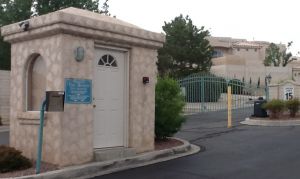
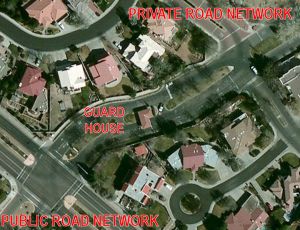
- Private Installation
- A set of drivable roads connected to the public road network, with one or more "gates" or "controlled access points". Some examples are: a gated community, a factory site, a military base. The simplest example is one private street protected by one gate. The largest USA private installation is White Sands Missile Range with 3,200 square miles. It includes dirt roads, primary streets and highways. A large private installation may even have smaller private installations inside of them.
- Gate
- Any point where a private installation road connects to the public road network. At these points might be a gate, traffic spikes, a guard, or simply a road sign. Gate opening might be controlled by cards, or remote "door buzzers". From now on, we will call all of these access control points "gates".
- Visitor
- Visitors must use visitor gates. They must not use member gates.Some examples are: the pizza delivery driver, the cousin from Peoria, the tourist visiting the air force base to see the military museum.
- Member
- Members may use both visitor gates and member gates. These member gates might have signs which say "members only", "residents only", "employees only", "authorized personnel only" or "military ID only".
Purpose
Routing must be reasonable
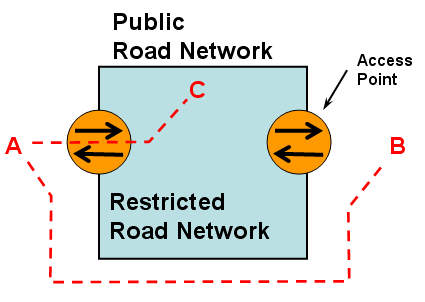
If a wazer starts and ends a drive outside the installation, Waze must not choose a route through the installation, even if it is faster. It must go around to get from point A to point B in figure 1. If the wazer is driving into or out of the installation, waze must choose a gate that gives the best route (from A to C or from C to A in figure 1).
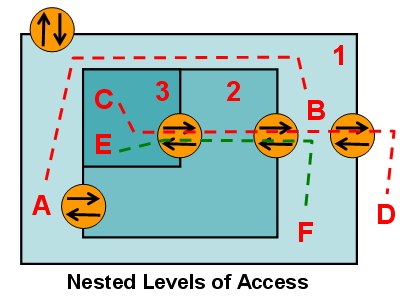
If one private installation is "nested" inside another private installation, routes must also be reasonable. The route from A to B in figure 2 must not go through a nested installation. a route from the deepest nested level to or from public roads (C to D or D to C in figure 2) uses the best gates. A route between different nested levels (between E and F) does not involve any nested installations it does not need to visit.
Waze should be able to take advantage of the characteristics of different road types and avoid dirt roads if the wazer requests it.
Must not cause map errors
Waze must not throw map errors when members drive through any entrances and exits. This means roads must not be disconnected or prohibited by red arrows at member gates.
As simple and straightforward as possible
While it is important to lock gates at a high enough level to prevent novice editors from breaking them, the gates should be easy for editors to spot and understand. In visitor-centric constructions, time based restrictions should not be used to prevent waze from routing wazers through member-only gates all day every day for all time.
Approach
Waze does not know who is a visitor and who is member, so we can't get Waze to give different directions for each. We have to choose whether to focus on members or visitors. This is the best Waze map editors can do with the tools currently available.
To make this work, editors must focus on the access points or gates, and control access by using the correct "recipe" for each type of gate. Inside the installation, every type of road can be used where appropriate. Do not make all the roads private inside the installation.
The six types of gates can be divided into two classes -- simple and everything else. For the simplest type of installation, where there is only one exit, a simple gate will work. For any installation that has more than one exit, the simple gate will cause strange routing out of the installation -- we don't know why -- and the other types of gates must be used. Never mix the simple gate with the other types of gates in the same installation.
Why this works
The current approach to constructing gates takes advantage of the Waze routing penalty system to control driving directions. For every route that includes private segments, Waze imposes a penalty each time the route goes from from' a Private segment to any other road type. This causes Waze to avoid driving through a private segment to get to the street on the other side, even if it has to find a longer and more time-consuming route to get there. Because of this, Waze editors can use private segments at gates to prevent Waze from giving routes that short-cut through private installations.
How to
All the segments used in gate recipes must be at least 19.69 ft (6 m) long. Check the house numbers. If they are supposed to be inside the installation, make sure they are not on any of the gate segments.
Remember to follow all best editing practices, including the rule against two segments sharing the same two junction nodes.
Simple Installations
Gate recipes
- Simple Gate -- one 2-way private road segment. If a place is used to mark the gate, put the stop point in the middle of the segment. Do not mix simple gates with any other type of gate in the same installation.
Application
If there is only a single entrance/exit, use a simple gate. If there is more than one exit or entrance, do not use any simple gates. If you use a Simple gate in a private installation with more than one exit, Waze will not find the best possible route out of the installation.
All other installations
| for the ongoing discussion of member-centric vs resident-centric routing, please see the current forum discussion |
Current Standard: Member-centric method
This method is used throughout the US, except in California, Arizona, and Nevada. Check with your State Manager or Regional Coordinator. Waze will use traffic information to route Wazers through the best gate for members. Visitors might be routed through a member gate and be refused admittance when they get there. Visitors can select the gate of their choice as their destination or "add a stop".
Gate Recipes
- Standard gate -- a one one-way private road segment heading into the installation, paired with a one-way segment heading out of the installation. The outgoing segment is of the same road type as the segments on either side of it. If a place is used to mark the gate, put the stop point as close as possible to the physical location of the gate.
Application
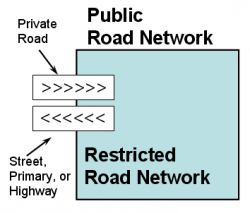
Each entrance to the installation should be connected by a one-way divided road entering and exiting the installation. The entering one-way road will include one private road segment. The exiting one-way road will be the same type of road (usually street, primary street, or minor highway) as the segments on either side of it. This structure often mimics the actual lanes for such installations. The private road segments, one way exiting segments, and surrounding roads should be locked with a high enough level lock to prevent novice editors from deleting or changing this control.
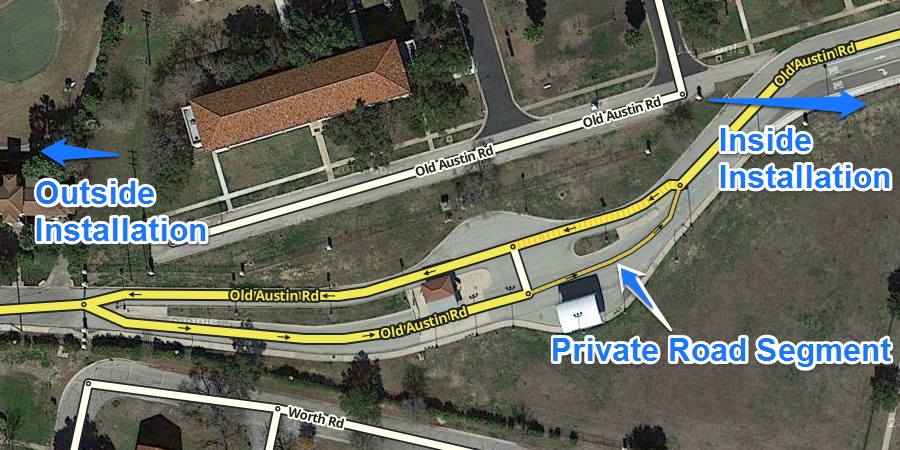

Nested private installations (wholly within another private installation) can be treated by this method or by one of the other methods.
- Pros
- The exiting road can be of any type and introduces no penalty to routing out of the installation.
- Cons
- A little more complicated than the simple approach.
| See warning above in the "Common Attributes" section about mixing the preferred and alternate treatments within the same nested level of a private installation. |
Visitor-centric method
In the US, this approach is used in California, Arizona, and Nevada. Do not use it anywhere else in the U.S. Check with your state manager or regional coordinator for more information. Waze will route everyone through the visitor's gates, which everyone can travel through. Waze does not route anyone through the member gates. Anyone wishing to use a specific member gate can "add a stop" at that gate. This method allows Waze to use traffic information to find the best route from among all available visitor gates. Members who live or work in the installation and travel in and out daily might not get the best route from Waze.
Gate recipes
- Visitor Entrance -- one one-way private road segment heading into the installation. If a place is used, put the stop point next to the middle of the private segment.
- Visitor Exit -- (nothing) no private segment is needed. Use the same road type as the rest of the road the gate is on. If a place is used to mark the gate, put the stop point as close as possible to the physical location of the gate.
- Member Entrance -- Three one-way segments, headed into the installation, in this order: private, street, private. If a place is used to mark the gate, put the stop point next to the middle of the middle street segment.
- Member Exit -- one one-way private segment. If a point place is used to mark the gate, put the stop point next to the middle of the private segment.
- Member 2-way gate -- Three 2-way segments, in this order: private, street, private. If a place is used to mark the gate, put the stop point next to the middle of the middle (street) segment.
- Closed Gates or fences -- these are closed nearly all the time, and only opened for special purposes -- disconnect the road at this point.
Application
A visitor entrance and visitor exit are combined as a
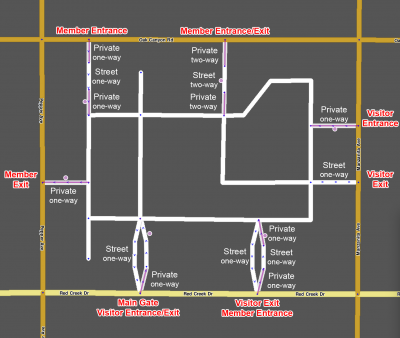
If there is more than one entrance or exit, do not use any simple gates. Instead, select from the other types of gates.Usually, gates come in matched entrance/exit pairs, but sometimes a single member-only exit is located at some distance from any entrances in a gated community. Remember that if visitors and guests can use a gate at the same location, even if they have separate lanes, it is not normally necessary to create separate gates on the map. Simply use a visitor entrance or exit: Wazers can generally follow the signs to enter or exit via the correct lane.
Nested Private Installations
When one private installation is located inside another, simply follow the same rules to construct all the gates for the smaller installation within the larger.
Checking your work
Check your work. If you run into any routing problems, check the discussions on the forums and ask questions in chat.
- Use the Waze Live Map to test routing between several pairs of test points inside and outside the installation.
- choose both "from" and "to" destinations from the mobile app to see the routes.
- Expect to see routes involving visitor gates.
- Watch for User Reports in the area. If users complain Waze will not route them through member-only gates, point them to how to add a stop along the way to go through their preferred gate. Waze can only route through the visitors gates
- if you have acces to the installation, try driving around outside, inside, from, and to the installation. Go off-route. Check that Waze re-routing makes sense -- routes in or out are always to the most sensible gate to reach your destination, not necessarily the nearest gate.
Optional ingredients
Gate Closures and Restrictions
If some gates are closed at certain times of day or days of the week, or on certain dates, use Scheduled Restrictions on the affected gate. Apply the restriction to just one gate segment. For a member entrance, apply it to the last-traversed (innermost) segment. Check to make sure entrance/exit pairs have the same closing hours.You can find the hours of gates or entry points through the private installation website or by calling the appropriate private installation authority.
Places or City Names
Small private installations are usually marked by a Area Place over their entire area. This does not make sense for larger private installations that might have other Places within them or that are actually cities. For these larger installations, use the city field of all street names to name the private installation.
If it meets any of these criteria, treat it as a city:
- Does the state DOT consider it a city?
- Does the US Post Office consider it a city with it's own zip code?
- Is it large enough that an overall Area Place on the Private Installation would obscure finer detail Area Places below?
Finally, if the local community considers it a city like entity, then maybe it should have a City Name if it is large, or an Area Place if it is small.
For places within the installation, follow the guidelines for point and area places. Also consider marking the following as Places because they are critical navigation and destination points:
- Entry/Exit gates (Place Area)
- Visitor Centers (Place Area)
- Museums and other similar visitor destinations
- Memorials
- Parade Fields
- Items locally useful for navigation
Alerting other Editors
Lock the gate segments so beginner editors will not break them. If a road is permanently blocked, disconnect the road at that point and leave a note. To create a note, use the Live Map to report a map problem. Begin the description with [NOTE], give your username, and explain the edit.
Places with special rules
Military Bases and Government Installations
Do not mark specific locations with a Place unless the it his is already public information found on road maps or the installation's public website, in maps or directories. Secure installations often do not provide information about hangar numbers, building numbers, organizational names.
Landmarks (Places) approved for military bases
- Commissary
- PX/BX
- Gas stations
- Parks
- Museums
- Visitor Gates
Parking Lots
Paid parking lots and other parking facilities are to be mapped with parking lot roads, and not according to the Private Installation rules defined in this article. See Best map editing practice#Parking Lots.
Theme Parks
Publicly accessible roads in a theme park, even after a pay-station/gate, are to be mapped with parking lot roads, similarly to other paid parking lots. Furthermore, be careful with mapping the "backstage" private roads which are only to be used by employees. It may be wise to not map these roads, similarly to "air-side" airport roads as described below (but to a lesser extent), so that routes are given to the public entrance of the theme park facility.
Airports
Only map airport roads which are accessible to the public (terminal pick-up/drop-off roads, parking lot access roads, etc.). Do not map "air-side" restricted road networks that allow traffic for baggage carts, service vehicles, airplane fuel tankers, etc. Here's why:
- Wazers use a variety of terms to search for airports. This means that, often, they wind up with a search result that came from a non-Waze service, and these are often closer to the air-side roads than to the public airport roads. Editors have carefully adjusted the map around most large airports to take this into account. Adding these private roads can cause Waze to route wazers to the "wrong side" of the airport through roads they will not be able to enter, and may cause them to miss their flights.
- The private air-side roads often run close to public roads. GPS error can cause Waze to think wazers on a public road are actually on the private road.
- Very few people use the private road network of an airport. A lot of people use an airport's public access roads.
- For those who want to navigate to employee or service entrances, create point places.
We apologize to airport employees and service providers.
When public airports are within military bases, use care and creativity in deciding which airport roads and which base roads should and should not be mapped. Check routing after making any changes.